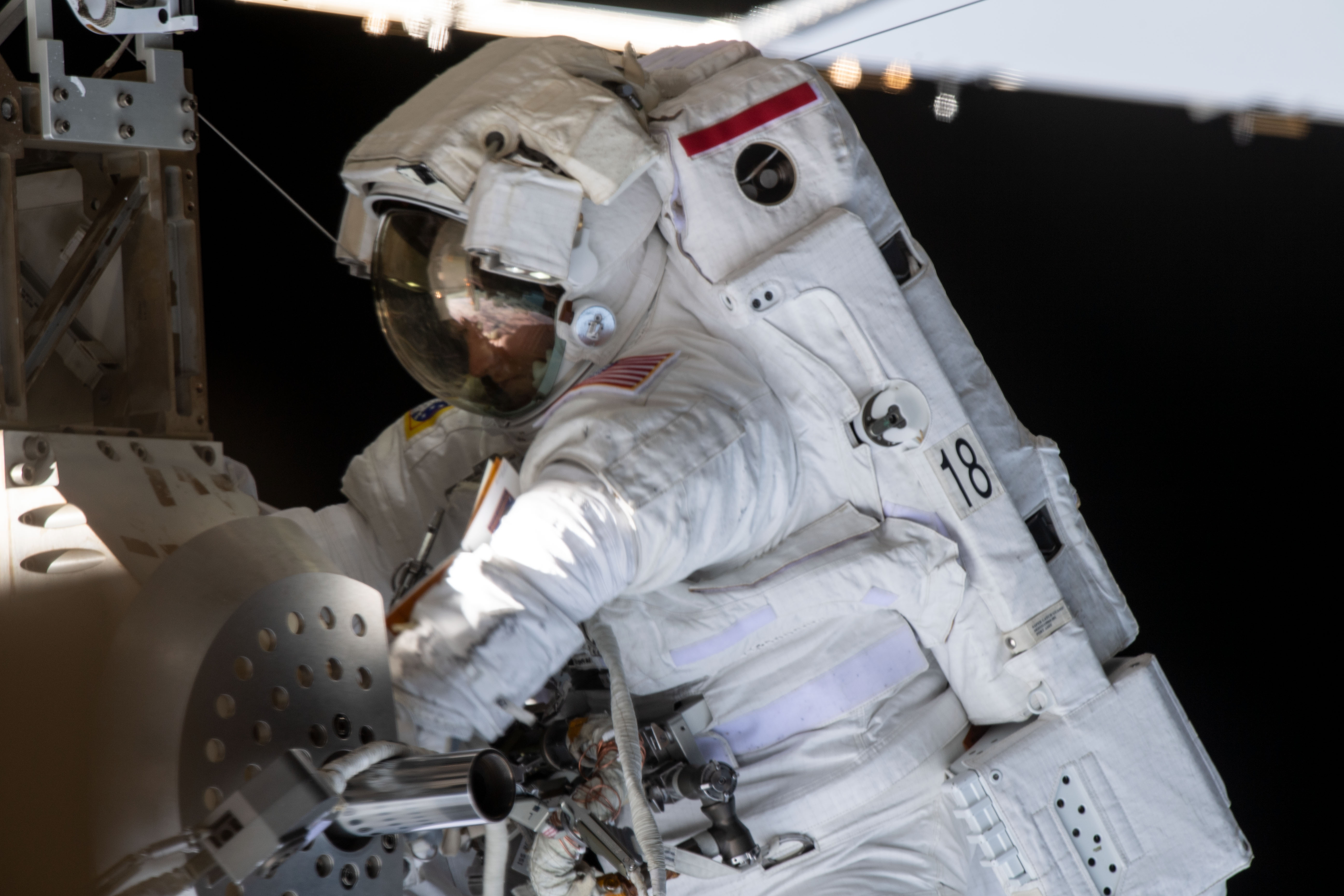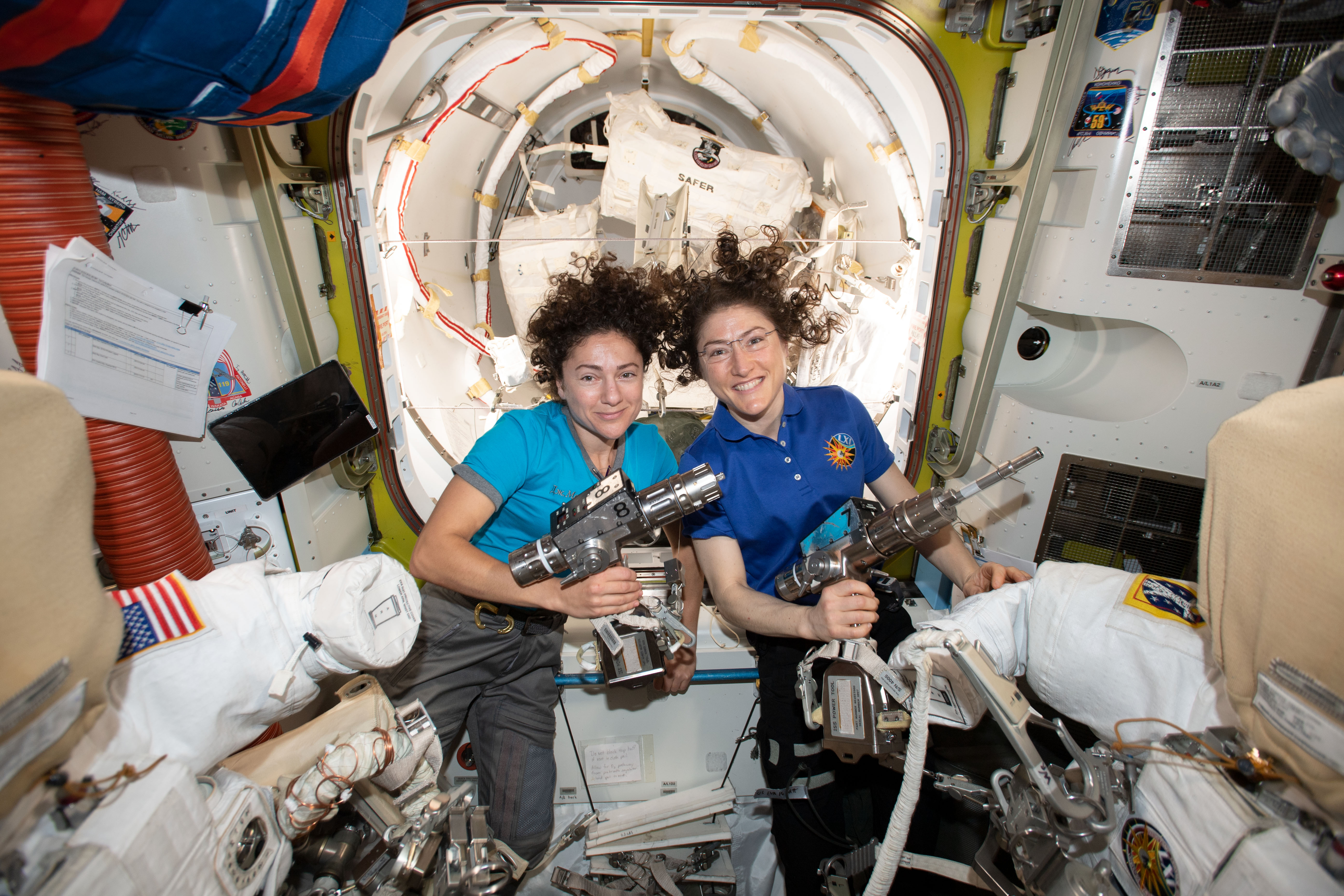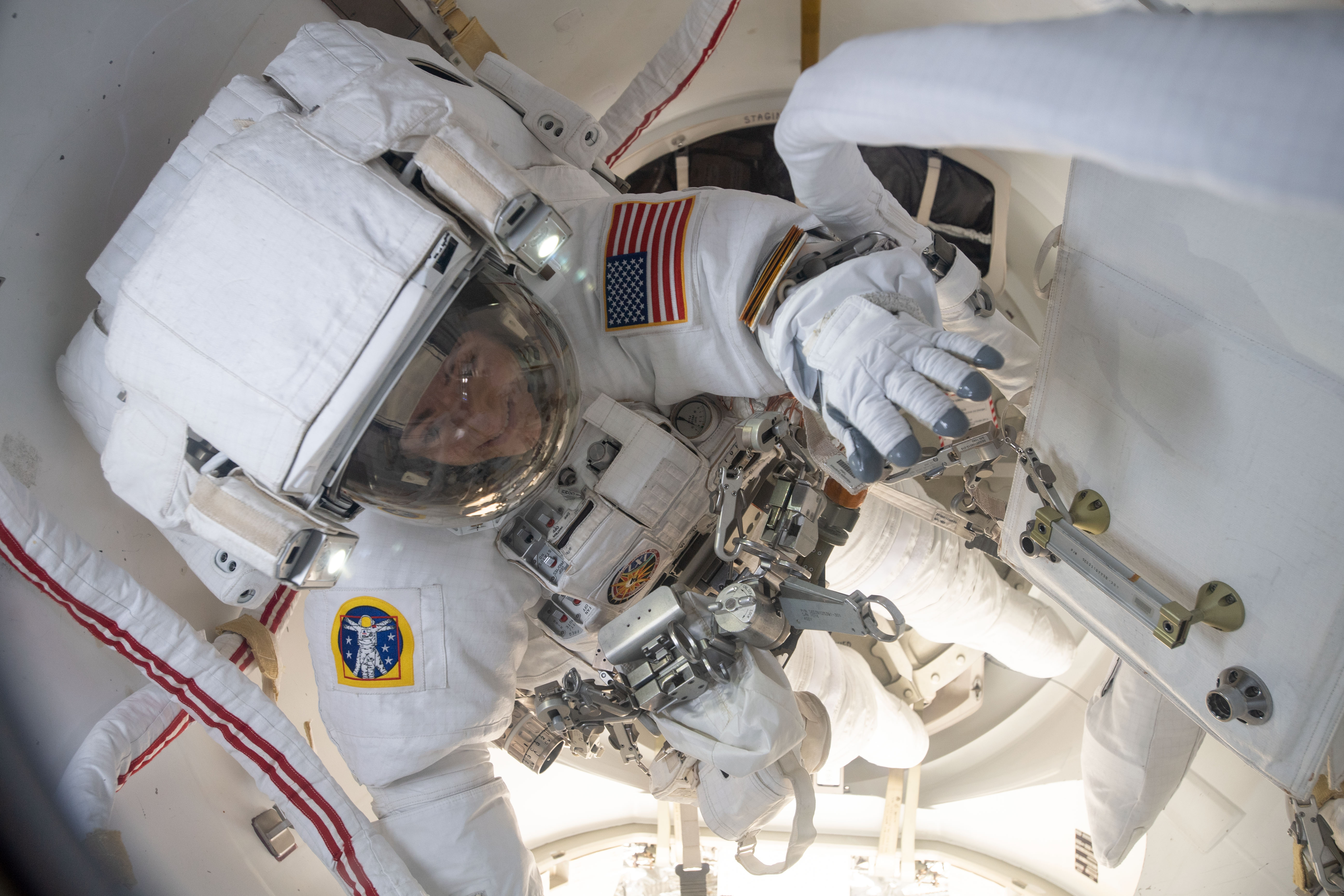
A dynamic duo of NASA women astronauts – Christina Koch and Jessica Meir – made history Friday, Oct. 18 when they carried out and successfully completed history’s first all-female spacewalk. Soaring some 400 kilometers above Earth while working and floating outside the International Space Station (ISS), they performed a critical task of swapping out a failed power distribution unit and restored full power to the orbiting research complex – all the while generating enormous global interest from the public.
During the 7-hour, 17-minute history-making spacewalk, the female pair – both on their rookie space flights – swapped out and replaced a faulty 230-pound power controller component, known as a battery charge-discharge unit (BCDU), with a new one.
The BCDU regulates the charge to the space station’s batteries that collect and distribute solar power to the orbiting lab’s systems. Power had been reduced by about four to five kilowatts as a result of the BCDU failure.
Mission controllers on the ground at Johnson Space Center in Houston activated the newly installed BCDU and reported it was operating properly towards the end of the spacewalk.
Ever since the first human spacewalk by Russian Cosmonaut Alexei Leonov in 1965 – who passed away just days ago – there have been hundreds of spacewalks carried out by humans both male and female.

The first-ever female spacewalk was carried by Russian cosmonaut Svetlana Savitskaya on July 24, 1984. She was followed three months later by the first American female to walk in space – NASA astronaut Kathryn Sullivan in October 1984.
But this was the first-ever spacewalk conducted only by a team of women astronauts. And it attracted interest from President Trump as well.
In fact, the president made a surprise call on Friday afternoon from the White House to the orbiting duo. He was joined by NASA Administrator Jim Bridenstine, Vice President Mike Pence and the president’s daughter, Ivanka, in an event televised live on NASA TV.

“I just want to congratulate you,” the president told the astronauts during the call while the EVA was in progress. “What you do is incredible. You’re very brave people, I don’t think I want to do it, I must tell you that. But you are amazing people. … Congratulations, Christina and Jessica, on this historic event.”
“Thank you,” Meir replied from orbit. “We don’t want to take too much credit because there have been many other female spacewalkers before us. This is just the first time there have been two women outside at the same time. … For us, this is really just us doing our job.
“At the same time, we recognize that it is a historic achievement and we do, of course, want to give credit to all those who came before us. There has been a long line of female scientists, explorers, engineers and astronauts, we are following in their footsteps to get us where we are today,” added Meir.
The spacewalk also called an EVA or extravehicular activity, was the 221st at the ISS for assembly and maintenance since construction started in 1998. A cumulative total of 57 days, 20 hours, and 29 minutes have been spent by astronauts working outside the space station.

The EVA by Expedition 61 Flight Engineers Koch and Meir began at 7:38 a.m. EDT from inside the Quest airlock when they switched their spacesuits to battery power. It concluded at 2:55 p.m. EDT when they returned inside the space station.
The entire EVA was carried live on NASA TV. You can watch a replay of it in the video embedded below.
Koch and Meir were assisted by Expedition 61 Commander Luca Parmitano of ESA, and NASA Flight Engineer Andrew Morgan. Parmitano operated the 57-foot long Canadarm2 robotic arm (SSRMS) moving the astronauts and unit, and Morgan provided airlock and spacesuit support.
Altogether there are 24 BCDU units on the ISS with three or four spares, according to NASA’s station manager Kenny Todd. There are no functioning spares on the ground as of today.

The BCDU unit they replaced failed to activate following the Oct. 11 installation of new lithium-ion solar array batteries on the space station’s exterior structure. Those batteries had been transported up to the ISS by Japan’s HTV-8 cargo ship in late September.
The BCDU removal and replacement work all went smoothly with no issues. The unit is located on the P6 truss segment beyond the reach of the Canadian robotic arm. Thus the astronauts were called upon to do the repair work themselves, unlike an earlier BCDU exchange carried out in March which was within reach of the robotic arm’s grasp.
This was the fourth spacewalk for Koch and the first for Meir. Koch has now accumulated a total of 27 hours and 48 minutes of spacewalking during her current mission. More EVAs for both are on tap in the coming weeks and months.
They both belong to the 2013 group of eight NASA astronauts selected – equally divided between men and women.

Meir thus became the 15th woman to spacewalk, and the 14th U.S. woman. It was the 43rd spacewalk to include a woman. Altogether 228 people have walked in space since Leonov in 1965, followed months later by NASA astronaut Ed White during Gemini 4.
The historic first all-woman EVA had generated public interest worldwide since it was recently announced. Some schools set up TV monitors for excited students to watch in real-time. However, this spacewalk by Koch and Meir was accelerated by about a week when the BCDU unit suddenly failed. NASA officials completely changed and revamped the purpose of this spacewalk to focus on replacement of the BCDU component. Initial plans had been to install another set of Li-ion batteries. That job is now tasked for spacewalks in upcoming months.

In fact, the first all-female spacewalk was initially scheduled for March 2019 with Koch and NASA astronaut Anne McClain. But that opportunity was canceled by NASA when it was unexpectedly determined there were not enough of the needed medium size spacesuits onboard the ISS to accommodate the two women.
Koch arrived at the ISS in March 2019. She will remain in space for an extended duration mission of 11 months – also setting a new record mission duration for a woman in space – to provide researchers the opportunity to observe effects of long-duration spaceflight on a woman to prepare for human missions to the Moon and Mars.
Meir just arrived at the station some 23 days earlier on the Russian Soyuz MS-15 mission that launched from the Baikonur Cosmodrome in Kazakhstan on Sept. 25 and docked six hours later.
Koch’s flight overall will fall just shy of being the longest ever duration mission set by an American in space – a record held by NASA astronaut Scott Kelly.

Koch and Meir are members of the six-person Expedition 61 crew currently serving onboard which also includes Russian and Italian nationals at this time.
The crew consists of NASA astronauts Christina Koch, Jessica Meir and Andrew Morgan as well as cosmonauts Alexander Skvortsov and Oleg Skripochka of Roscosmos and ESA astronaut Luca Parmitano.
The faulty BCDU is due to return to Earth on the next SpaceX Dragon resupply ship for inspection. The CRS-19 mission is set to launch as early as December.
“Station managers will reschedule the three battery replacement spacewalks for a future date,” said NASA officials. “In the meantime, the five planned spacewalks to repair a cosmic particle detector, the Alpha Magnetic Spectrometer, are still on the calendar for November and December.”
The next cargo freighter launch to the ISS is slated for Nov. 2 via the Northrop Grumman Cygnus NG-12 commercial resupply mission from NASA Wallops in Virginia.
Watch the complete video of the historic first all-female spacewalk in its entirety here:



